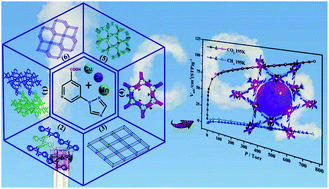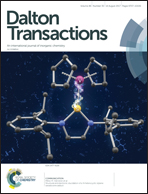The influence of coordination modes and active sites of a 5-(triazol-1-yl) nicotinic ligand on the assembly of diverse MOFs†
Abstract
Six new complexes based on 5-(triazol-1-yl)nicotinic acid (HL), namely [Cu2(L)3(H2O)(OH)]n (1), [Co(L)2(H2O)2]n (2), [Mn(L)2(H2O)2]n (3), {[Co(L)(H2O)0.5(DMF)0.5(NO3)0.5]·(Cl)0.5·DMF·2H2O}n (4), {[Cu(L)(O)0.5]·CH3OH·2.5H2O}n (5) and {[Co2(L)4(H2O)]·2DMA·2H2O}n (6), were synthesized under hydro(solvo)thermal conditions. The L− ligand in 1–6 reveals various coordination modes and forms diverse secondary building units (SBUs) in the final structures. Complex 1 shows a 2D layered structure with a rare (3,8)-connected topology based on tetranuclear [Cu4(COO)6(H2O)2(OH)2N6] SBUs. 2 and 3 are isostructural and display 2D 4-connected sql nets with a point symbol of (44·62). 4 and 5 have similar spatial 3D porous frameworks, which can be simplified as a (3,6)-connected 2-nodal net via dinuclear [Co2(COO)2(O)2(NO3)(N)4] SBUs and [Cu2(COO)2(O)(N)4] SBUs, respectively. 6 is a 3D porous framework constructed by dinuclear [Co2(COO)4(H2O)(N)4] motifs with a uninodal 4-connected qtz net. The magnetic properties and gas sorption behaviour of these complexes were investigated carefully, showing that 3 exhibits ferrimagnetic character and 4 demonstrates its effective storage capacity for CO2 as well as high selectivity for CO2 over CH4 under ambient conditions.



 Please wait while we load your content...
Please wait while we load your content...